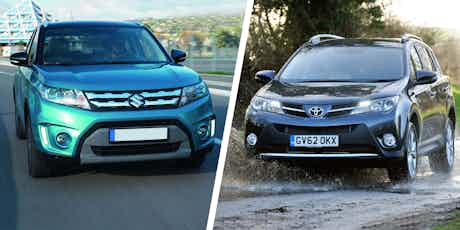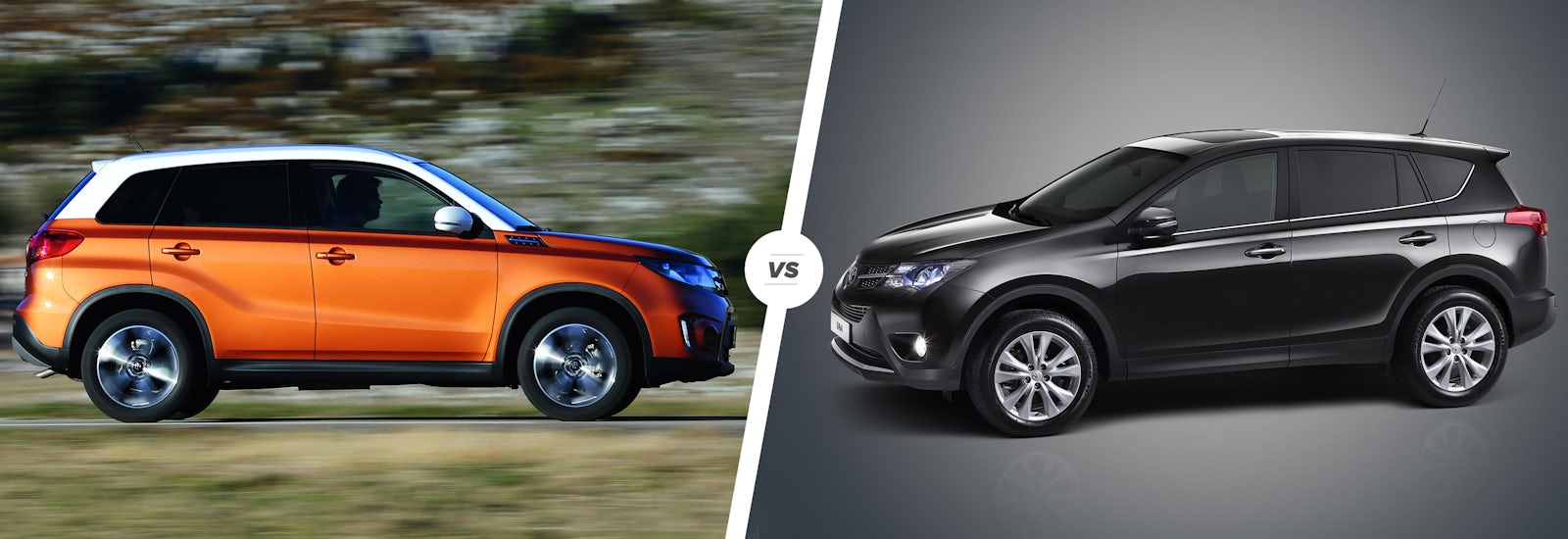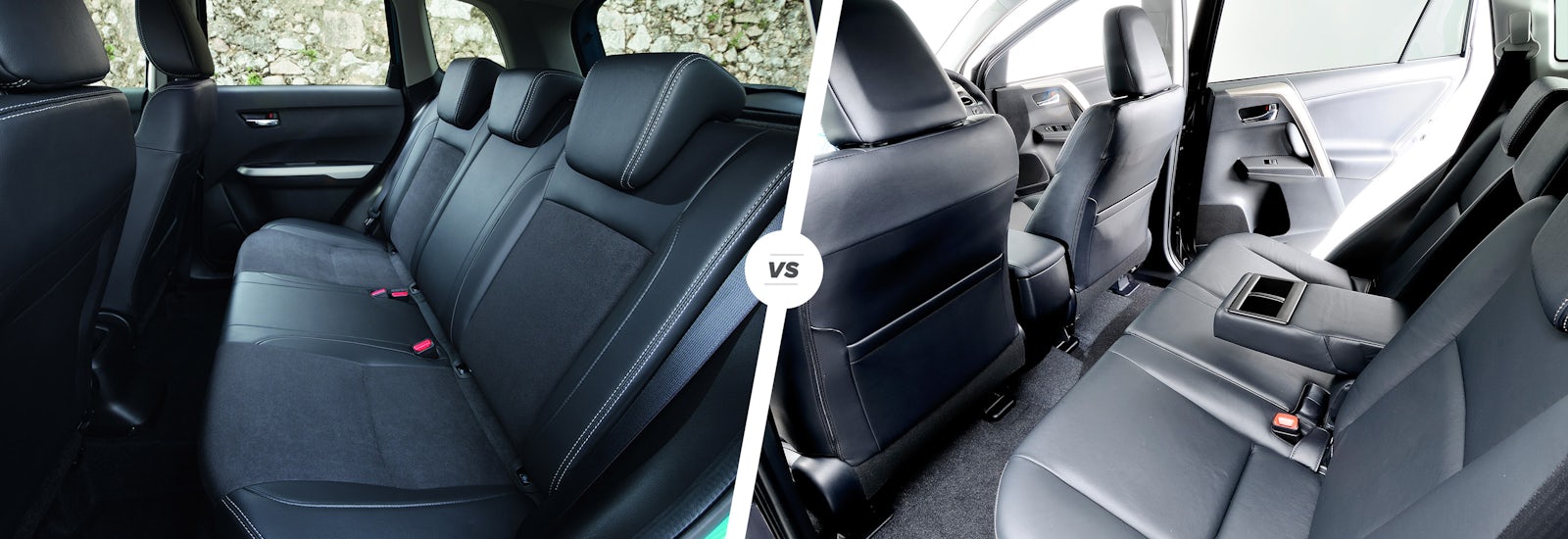Suzuki Vitara vs Toyota RAV4: battle of the SUVs
May 20, 2015 by carwow staff

SUV-crossovers are definitely in hot demand in the motoring world at the moment. They combine family hatchback-like driving dynamics with the added practicality and off-road capabilities that come from much larger vehicles.
Stepping into this hotly contested market is the new Suzuki Vitara – a replacement for the Grand Vitara which has been designed be much cleaner and more fun to drive. So how will it fare against one of the markets most regular and dependable work-horses, the Toyota RAV4? Read on to find out…

Styling
Styling is a subjective matter and, in a market such as this, an SUV’s looks aren’t as important as a supermini’s or a saloon’s. It’s really about how practical they are or how comfortable and economical they can be. Despite this, a car that looks ugly can’t bet on generating a lot of interest from buyers.
Apart from the differences in sizes between the two – the RAV4 is longer, wider and taller than the Vitara – the Suzuki is the more distinctly styled of the two. The RAV4 looks like a conventional SUV with no real styling cues to set it apart from the rest of the pack. The Suzuki, on the other hand, is a much more handsome car. Yes, the rear-end is nothing to shout about, but the front’s broad grin is unlike anything else in this sector.
You can get the Suzuki in many funky paint colours, including some two-tone designs. You can also opt for design packs that further add to the Vitara’s exterior appeal. It’s not just the outside either – you can choose between many trim schemes which all add a specific coloured strip to the dashboard – like what you’d find in a Citroen DS3.

Interior
Out of the two, the Toyota RAV4 has the better interior. It uses more soft-touch materials where the Suzuki uses more scratchy hard plastics. The Suzuki isn’t a bad place to sit though – everything is logically laid out, the dials are easy to read, and the seats are comfortable. The RAV4 just feels like the more expensive machine when sat inside. What’s even more noticeable than the plusher materials used is the dashboard buttons have a more refined ‘Germanic’ feel to them. This is to be expected as Toyota is renowned for its bulletproof interior quality.
What both cars share is they both give the driver great levels of visibility, they’re both supremely comfortable and they’re very easy to use. Their infotainment touch screen systems also have great graphics.
The Suzuki comes with more standard equipment including a CD player, DAB digital radio, Bluetooth, cruise control, automatic air-conditioning and a USB port. The RAV4 comes with 17-inch alloys, Bluetooth and only basic air-conditioning.

Engines
The Toyota has a more versatile range of engines with two diesels (a 2.2 and 2.0-litre) and one petrol option (2.0-litre) while the Suzuki only comes with one petrol and one diesel (both 1.6-litres). The engines in the Toyota are marginally more powerful and therefore make the car quicker overall, but the ones in the Suzuki are more economical with the 1.6-litre diesel returning upwards of 71mpg while the best Toyota can only muster 58mpg.

Driving
Neither car will set the world alight in this department but they still need to be good in order to succeed in such a competitive marketplace.
Their naturally taller dimensions mean there’s noticeable body-roll in both cars when going round corners but the trade-off is a comfortable ride. The Vitara is the better to drive because it’s lighter so there’s less inertia for the car to overcome. The Suzuki’s greater sense of control means you can tackle a back route British B-road with more confidence than in the Toyota.
It has to be said, though, that both are equally refined and they have nice smooth gearboxes (manual and automatic) but the steering systems could be worked upon to inspire more confidence. They’re made for comfort and ease-of-use more than drivability which is fine in town but, on the open-road, it’s something that can be a hindrance.

Practicality
Both are exemplary in this regard with interiors with plenty of cubby areas to store things and both provide passengers with excellent levels of head- and legroom both in the front as well as in the rear. The Toyota probably edges out on passenger space thanks to its larger dimensions in all directions.
The Toyota has a considerably bigger boot with 172 more litres than the Vitara with the rear seats in place (547 against 375). This also doesn’t include the extra 100-litres of space the Toyota offers underneath the boot floor where a spare-wheel would be located. Both cars’ boots are cleverly designed, however – they’re still very practical and heavy items shouldn’t be a problem with low load-lips and seats which fold almost completely flat.

Which should I buy?
Of the two, if you’re looking for the one which feels more expensive or the one which is the most practical with the most amount of room inside, then it’s the Toyota RAV4 you’ll be after.
But – and this is a very big but – you will have to pay the extra for it. Compared to the Suzuki Vitara, the Toyota is as much as £8,500 more expensive. When you look at that price gap, the Toyota simply isn’t worth that amount of extra cash. You could buy the Suzuki and you’d still be able to get a brand new Skoda Citigo with spare cash lying around at the end.
The Suzuki does everything you could possibly want in a car – good practicality, economical engines, solid build quality, decent comfortable and plenty of space for passengers. You simply cannot ignore this car at this price.
What next?
If you like the look of the Suzuki Vitara or the Toyota RAV4, check them out in our car configurator to see how much carwow could help you save. Or, for more options, head over to our deals page to see our latest discounts.















